Realism |
Realism |

| Some changes in artistic aims take decades. Toward the middle of the nineteenth century, when some artists were still painting works clearly defined as "Romantic," a new movement was afoot: realism. Realism can be defined in two primary ways. 1) Subject matter. Whereas Neoclassical artists were attracted to Greek and Roman subject matter and Romantics often painted medieval and Biblical subjects, realists were interested in contemporary events and ordinary life. Instead of the Death of Socrates or the Death of Sardanapalus, a realist might paint the death of an ordinary person. See, for example, the banner above, a detail of Courbet's Funeral at Ornans, which depicts the funeral of one of his unheroic relatives in an unimportant town. The rejection of subjects deriving from historical and literary sources is essentially the rejection of the "Academy," or the art authorities of the day. Realists were often seen as rebels because they departed from the standards of these authorities who controlled the art schools and the exhibit spaces.
2) Treatment of subject. Contrast the two compositions below. | |
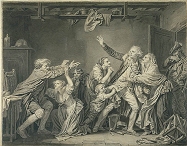 |
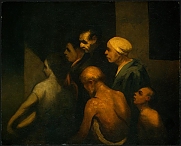 |
| The engraving at the left of a late 18th century painting is stagey and unnatural, in short, unreal. Even feeling extreme emotions, people rarely use these kinds of artificial gestures with outflung arms and eyes rolled up to heaven. The painting on the right, Honoré Daumier's The Beggars, is more realistic. Even though the figures are arranged in the center of the canvas in the High Renaissance pyramidal composition, their attitudes seem natural and they seem unposed, not even facing the viewer--the way real people appear, as if in a spontaneous snapshot. Realistic artists, then, will focus on ordinary, real subjects depicted in natural unposed ways. | |
| One might reasonably ask why the term "realism" is used so late in the history of western art. Weren't Renaissance men and women, for example, interested in their own world? The key to this question is the phrase "their own world." In the Renaissance painters did depict wealthy persons who could afford to have their visages recorded. Somewhat later, artists rendered settings carefully in genre paintings. But this "realism" was restricted to the upper and middle-classes. Furthermore, paintings were a luxury item seen by a small and exclusive audience. With the advent of prints visual representations were available in multiples and therefore inexpensive. By the nineteenth century etchings and aquatints had developed so that books could be easily illustrated. A lower middle-class person could afford a single print like the one above; it could be framed and used as household decoration. There were different expectations from prints, however; they often were not thought of as "high art" and typically they illustrated interesting contemporary events, people, and places. This means that ordinary people were becoming accustomed to seeing their own world in "popular art"--in magazines and on their own walls. New media in the first half of the nineteenth century also contributed to the development of realism. All over Europe viewers were excited by the Panorama--a huge circular painting on a circular wall, usually of the city it was exhibited in; sometimes viewers walked around the painting or sometimes they remained stationary while it revolved on rollers. The Panorama was exhibited in a building designed for it with special lighting effects. The Diorama was also popular. It was a huge painting with dramatic lighting effects which made it seem as if the details in the painting were moving. These two inventions suggest that the middle class public wanted to see its own world represented; this audience wanted to see a familiar, if ordinary world. By the 1830's there was an image explosion, created by the popular illustrated press and the invention of photography. Until this time pictures had been relatively rare for most people; now images were available by the thousands and could be torn out of magazines and exhibited in the home. Ordinary people could own images and began to learn about the world through pictures as well as words. As Gerald Needham explains, a series of inventions came together to make cheap newspapers and magazines readily available: "the steam [printing] press, cheap newsprint that would go through high-speed presses without tearing, cheap ink that would not smear, and mechanized typesetting. The simultaneous spread of railroads provided a rapid means of distribution for the magazines, further increasing circulation and reducing prices" (35). A number of these magazines had a democratic intent and educational purpose providing illustrated articles on a wide variety of subjects--everything from new technology to the urban problems that accompanied industrialization, to international news. These illustrations served to break down the heirarchies of visual representation and provided a precedent, often several decades earlier, for the subjects that so-called realist artists would depict in their works. | |
Below are some illustrations from The Penny Magazine, a magazine published every Saturday in Victorian England and marketed to a working class audience. (See this website.) As the website says "it was a source of information on subects of general interest: everyday things like tea and coffe, well-known places in England, a series of animals and birds in Britain, descriptions of present-day manufacturing" with several illustrations per issue. Illustrations of articles in The Penny Magazine: a porpoise; the Bishop's Throne in Durham Cathedral [Durham, England]; a coracle (a one-man boat invented by ancient Britons but still used for inland navigation in some parts of South Wales) | ||
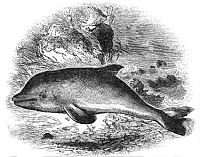 |
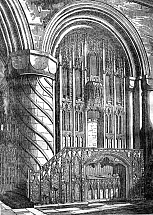 |
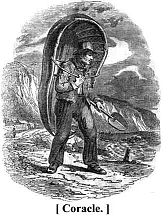 |
Some aspects of Romanticism may have also contributed to the development of Realism. Wordsworth said in the Preface to the Lyrical Ballads: "The principal object, then, proposed in these poems was to choose incidents and situations from common life, and to relate or describe them, throughout, as far as was possible in a selection of the language really used by men." | ||
| John Constable (1776-1837) | ||
|
Parham Mill at Gillingham 1826 | ||
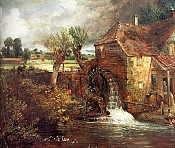 |
Recall also that the landscapes of the romantic painter Constable were often of ordinary English mills and waterways. Here, as often, the title identifies the specific "real" place. In addition, Constable made careful studies, observing nature carefully. These are the habits of a realist. | |
Constable's studies of clouds and trees | ||
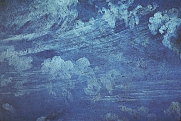 |
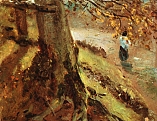 |
|
Continue below to learn about specific realist artists | ||
 |
Daumier | |
 |
Courbet | |
 |
Other Realists | |
 |
Photography | |
All images marked MAS were photographed on location by Mary Ann Sullivan. All other images were scanned from other sources or downloaded from the World Wide Web; they are posted on this password-protected site for educational purposes, at Bluffton College only, under the "fair use" clause of U.S. copyright law.